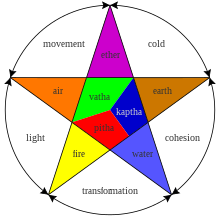Ayurveda - The Science of Life
Ayurveda is a 5,000-year-old system of natural healing that has its origins in the Vedic culture of India. Although suppressed during years of foreign occupation, Ayurveda has been enjoying a major resurgence in both its native land and throughout the world. Tibetan medicine and Traditional Chinese Medicine both have their roots in Ayurveda. Early Greek medicine also embraced many concepts originally described in the classical ayurvedic medical texts dating back thousands of years.
More than a mere system of treating illness, Ayurveda is a science of life (Ayur = life,Veda = science or knowledge). It offers a body of wisdom designed to help people stay vital while realizing their full human potential. Providing guidelines on ideal daily and seasonal routines, diet, behavior and the proper use of our senses, Ayurveda reminds us that health is the balanced and dynamic integration between our environment, body, mind, and spirit
Eight components of Ayurveda
(General medicine) – Kāya-chikitsā: "cure of diseases affecting the body"(Pediatrics) – Kaumāra-bhṛtya: "treatment of children"
(Surgery) – Śhalya-chikitsā: "removal of any substance which has entered the body (as extraction of darts, of splinters, etc.)"
(Ophthalmology / ENT/Dentistry) – Śālākya-tantra: "cure of diseases of the teeth, eye, nose or ear etc. by sharp instruments"[dubious – discuss]
(Demonology / exorcism / psychiatry) – Bhoot (ghost)-vidyā: "treatment of mental diseases"
(Toxicology) – Agada-tantra:Gada means Poison. "doctrine of antidotes"
(Anti Agings) – Rasayana-tantra: "doctrine of Rasayana"
(Aphrodisiacs) – Vājīkaraṇa tantra
Principles and terminology

Several philosophers in India combined religion and traditional medicine—notable examples being that of Hinduism and Ayurveda. Shown in the image is the philosopher Nagarjuna known chiefly for his doctrine of the Madhyamaka (middle path) who wrote medical works The Hundred Prescriptions and The Precious Collection, among others.

The three doṣas and the 5 elements from which they are composed.
There are two ways in which to approach Ayurvedic principles and terminology: one may either focus on the historical foundation (as evidenced in the oldest Ayurvedic texts, going back to the early centuries of the Common Era) or, alternatively, a description may take an ethnographic approach and focus on the forms of traditional medicine prevalent across India today.
Much like the medicine of classical antiquity, Ayurveda has historically taken the approach of enumerating bodily substances in the framework of the five classical elements (Sanskrit [maha]panchabhuta, viz. earth, water, fire, air and aether. Moreover, Ayurveda names seven basic tissues (dhatu). They are plasma (rasa), blood (rakta), muscles (maṃsa), fat (meda), bone (asthi), marrow (majja), and semen (shukra).
Further information: Mahābhūta
Ayurveda states that a balance of the three elemental substances, the Doshas, equals health, while imbalance equals disease. There are three doshas: Vata, Pitta and Kapha. One Ayurvedic theory states that each human possesses a unique combination of these doshas which define this person's temperament and characteristics. Each person has a natural state, or natural combination of these three elements, and should seek balance by modulating their behavior or environment. In this way they can increase or decrease the doshas they lack or have an abundance of respectively. Another view present in the ancient literature states that dosha equality is identical to health, and that persons with imbalance of dosha are proportionately unhealthy, because they are not in their natural state of balance. Prakriti is one of the most important concepts in Ayurveda.
Further information: Dosha
In Ayurvedic theory, there are 20 qualities or characteristics (guṇas), which are inherent in all substances. They can be arranged in ten pairs of antonyms: heavy/light, cold/hot, unctuous/dry, dull/sharp, stable/mobile, soft/hard, non-slimy/slimy, smooth/coarse, minute/gross, viscous/liquid.
Guna
Ensuring the proper functions of channels (srotas) that transport fluids is one part of Ayurvedic treatment, because a lack of healthy channels is thought to cause diseases. Practitioners treat patients with massages using oils and Swedana(fomentation) to open up these channels.
Hinduism and Buddhism have had an influence on the development of many of Ayurveda's central ideas. Balance is emphasised; suppressing natural urges is considered unhealthy and claimed to lead to illness; to suppress sneezing, for example, may give rise to shoulder pain. However, people are also cautioned to stay within the limits of reasonable balance and measure when following nature's urges. For example, emphasis is placed on moderation of food intake,sleep, and sexual intercourse.

No comments:
Post a Comment